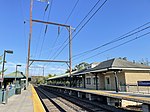Great Train Wreck of 1856
1850s fires in North America1856 fires1856 in Pennsylvania19th-century fires in the United StatesAccidents and incidents involving North Pennsylvania Railroad ... and 12 more
Derailments in the United StatesExplosions in 1856Industrial fires and explosions in the United StatesJuly 1856 eventsRailway accidents and incidents in PennsylvaniaRailway accidents in 1856Railway boiler explosionsTrain and rapid transit firesTrain collisions in the United StatesUpper Dublin Township, PennsylvaniaUse American English from August 2020Use mdy dates from August 2020

The Great Train Wreck of 1856 occurred in Whitemarsh Township, Pennsylvania, between Camp Hill station (formally know as Sandy Run, Camp Hill, Sellwick and finally Fellwick station before being closed in 1996) and Fort Washington station, on July 17, 1856. Two trains, traveling on the same track in converging directions, collided, killing between 59 and 67, and injuring over 100. The incident was referred to as The Camp Hill Disaster in Montgomery County, and The Picnic Train Tragedy in Philadelphia. It was the deadliest railroad catastrophe in the world up to that time and became one of the signature events of its era.
Excerpt from the Wikipedia article Great Train Wreck of 1856 (License: CC BY-SA 3.0, Authors, Images).Great Train Wreck of 1856
Pennsylvania Avenue,
Geographical coordinates (GPS) Address Nearby Places Show on map
Geographical coordinates (GPS)
| Latitude | Longitude |
|---|---|
| N 40.128794444444 ° | E -75.202933333333 ° |
Address
Pennsylvania Avenue 710
19034
Pennsylvania, United States
Open on Google Maps







